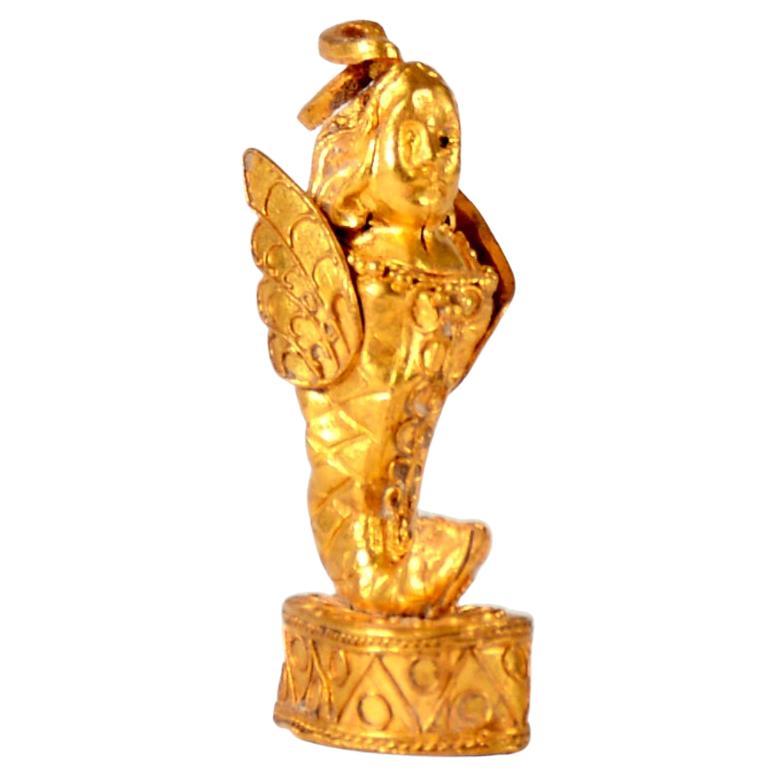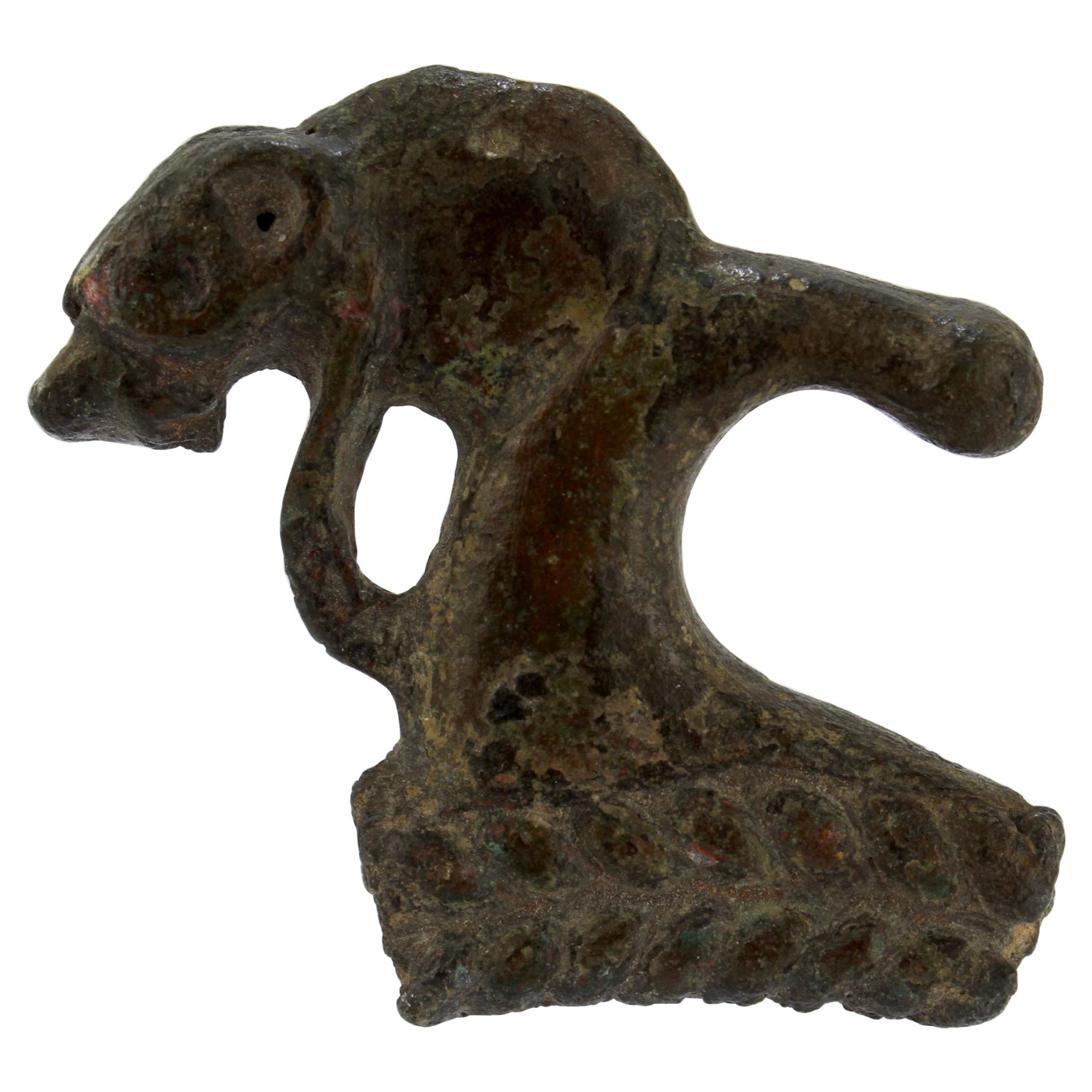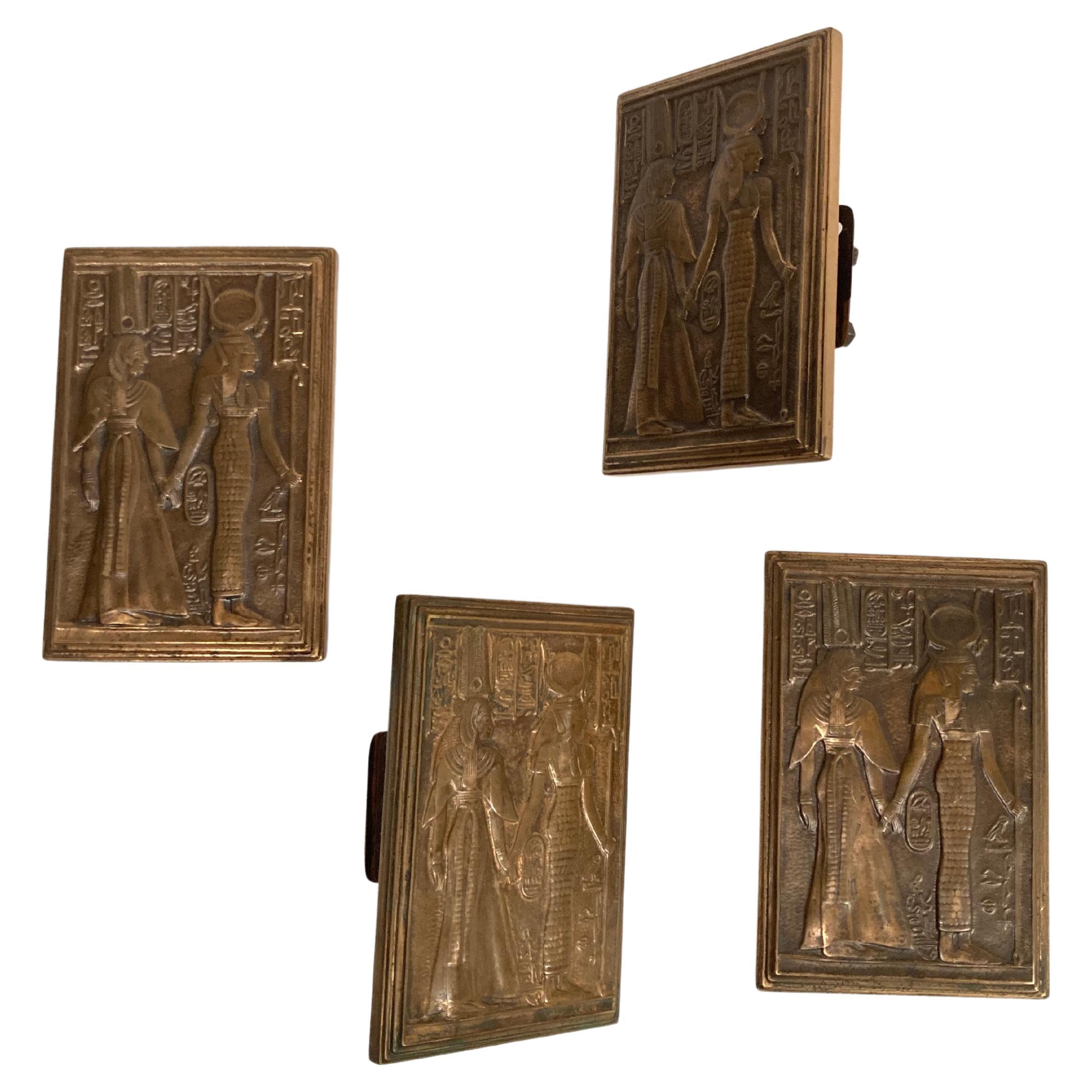Want more images or videos?
Request additional images or videos from the seller
1 of 8
Bronze Siren
About the Item
Sirens were dangerous bird-like females who tempted sailors with their hauntingly beautiful song. In Homer’s Odyssey (XII, 39) Odysseus and his sailors were warned about the lethal consequences of succumbing to the music of the sirens. Odysseus had to be lashed to the mast of his ship, and his sailors filled their ears with beeswax in order to avoid the sirens’ allure.
After centuries of verbal story-telling in the region, the Homeric epics were written down around the end of the 8th century or the beginning of the 7th century B.C. And although no visual description was given by Homer, by the 7th century B.C., sirens were regularly depicted in art as human-headed birds, possibly influenced by the Ba -bird of Egyptian religion. In early Greek art, the sirens were generally represented as large birds with women's heads, bird feathers and scaly feet.
This beautifully modelled figure was possibly an attachment or terminal to a bronze vessel or mirror. However the shaping and lack of attachment loops or flat surface plates suggest that this could also have been a stand-alone votive figure. With a placid face, upright body, slightly flaring incised wings and claw-like talons, this female siren has close comparables found in the Metropolitan Museum, New York and the British Museum (1865,0720.46), although both lack the definition and beauty of the present example.
Provenance:
Previously in the Private Collection of museum curator, publisher and director of the Presses Universitaires de France between 1934-1976 Mr Paul-Joseph Angoulvent (1899-1976), France, prior to 1976.
Thence by descent, France (accompanied by French cultural passport 238899).
ALR: S00226288, with IADAA certificate, this item has been checked against the Interpol database.
- Dimensions:Height: 2.17 in (5.5 cm)Width: 1.38 in (3.5 cm)Depth: 0.99 in (2.5 cm)
- Style:Classical Greek (Of the Period)
- Materials and Techniques:
- Place of Origin:
- Period:
- Date of Manufacture:4th to 5th Century B.C
- Condition:Wear consistent with age and use.
- Seller Location:London, GB
- Reference Number:
About the Seller
5.0
Vetted Seller
These experienced sellers undergo a comprehensive evaluation by our team of in-house experts.
Established in 1910
1stDibs seller since 2020
- ShippingRetrieving quote...Ships From: London, United Kingdom
- Return PolicyThis item cannot be returned.
More From This SellerView All
- Bronze HoardLocated in London, GBDagger L: 27.8 cm, Luniform bronze, possibly a belt buckle L: 10.8 cm, Shield-shaped bronze with a point Diam: 6.5 cm, Pommel Diam: 3.7 cm, Violin-bow brooch L: 17.5 cm, P-Shape...Category
Antique 15th Century and Earlier European Classical Roman Antiquities
MaterialsBronze
- Anglo-Saxon Hanging BowlLocated in London, GBA very rare and near-complete copper-alloy hanging bowl and associated fittings. Crafted from a single sheet of bronze, the body of the bowl is curved, with a slightly recessed lip. ...Category
Antique 15th Century and Earlier English Antiquities
MaterialsBronze
- Statuette of the Goddess NeithLocated in London, GBBronze statue of the goddess Neith, striding, her left foot extended forward. Her left hand is extended forward and formally held a papyrus sceptre, a fragmentary ankh is visible in her right hand. She wears a close-fitting sheath dress, incised with a broad usekh collar, and carefully engraved bracelets and armlets. On her head is the Red Crown of Lower Egypt, decorated with vertical striations and restored spiral and spire. Her face is finely molded, with a broad upturned nose and electrum-overlaid eyes and eyebrows. Neith was one of the earliest recorded gods in the Egyptian pantheon, worshipped from early in the Predynastic era through to the arrival of Roman rule. A war goddess and goddess of weaving, she was the patron goddess of the Red Crown of Lower Egypt and the city of Zau (Sais, in the 5th Nome of Lower Egypt) in the Delta. A powerful and popular goddess, she was, according to the Iunyt (Esna) cosmology, the creator of the world and the mother of the sun, Ra. This made her the mother of all of the gods, who often came to her to settle their disputes. Her symbols are the bow and arrows and a sword and shield as a war goddess, a weaving shuttle as a funerary goddess, and the Red Crown of Lower Egypt as the goddess of creation and mother goddess. She is usually depicted as a woman wearing the Red Crown of Lower Egypt, however, she is occasionally depicted as a cow in connection with her role as the mother of Ra. The use of electrum, a naturally occurring alloy of gold and silver sometimes called ‘green-gold’, for the eyes speaks to the high status of the object. Electrum had been used by the Egyptians since at least the 3rd millennium B.C., but, give its rarity, was reserved for the most expensive and important objects. Most electrum used in Egypt was imported from Nubia, though some was found there. Published: Parke-Bernet Galleries, New York, February 25th, 1971, no. 70, illus. Sotheby’s, New York, June 5th, 1999, no. 31, illus. David Aaron Ltd...Category
Antique 15th Century and Earlier Egyptian Egyptian Antiquities
MaterialsBronze
- Two Glass Inlay PairsLocated in London, GBTwo pairs of two halves from the same bar, finely detailed, with pointed ears and eyebrows, opaque yellow face, opaque red on the mouth, nose, eyes and ears, translucent cobalt blue edges to the mouth, nose and ears, with translucent emerald green leaves above and between the translucent cobalt blue brows and eye line, translucent pink pupils, with translucent cobalt blie and opaque white snake scales below the face, in translucent cobalt blue matrix, cut in the lower part of a cartouche design. These rare heads might represent the Agathos Daimon, the tutelary deity of Alexandria, who was also identified with Serapis, the male counterpart of Isis-Thermouthis (who in turn was a graecisized form of the early snake harvest goddess Renenutet). In a statue of Isis-Thermouthis in Alexandria museum (no. 25773, ex-collection King Farouk I), reproduced in Gotten, Pharaonen, no. 151, the snake goddess...Category
Antique 15th Century and Earlier Egyptian Antiquities
MaterialsGlass
- South Arabian Head of a WomanLocated in London, GBA female head finely carved from evenly-coloured cream alabaster. The face features a strong chin, high rounded cheekbones, and large elliptical eyes deeply inset for inlays. The remains of the nose indicate that it was long, thin, and roughly triangular in form. A small, round mouth sits just below the nose. Deeply incised eyebrows follow the shape of the eyes, which are framed by unusual grooved canthi on either side, possibly to represent cosmetic eye paint. The supraorbital margins above the eyes are deeply carved, while the carving below the eyes is more subtle, smoothing the sockets into the rounded cheeks. The ears are formed from two arcs and a central sphere, and both lobes are pierced for earrings. The long hair frames the face below the ears, and is carved to create a rougher texture. There is a stock sticker on the back of the neck. A fragment of the right shoulder remains. This suggests that the head was part of a larger sculpture, possibly a full figure (though this seems unlikely due to its relatively large scale) or, more likely, a bust. This head is stylistically aligned with those found at Timna, the capital of the ancient Yemeni kingdom of Qataban, which existed from the 1st millennium BC until the late 1st or 2nd centuries AD. Timna served as an important hub of the Incense Route, the camel caravan that transported incense from Arabia and India to ports on the Mediterranean Sea. Roman author and philosopher Pliny the Elder (23/24-79 AD) described Timna as a busy city with around 65 temples. Excavations in 1950 and 1951 by Wendell Phillips...Category
Antique 15th Century and Earlier European Antiquities
MaterialsAlabaster
- Megalithic StelaLocated in London, GBA tall anthropomorphic stele of carved granite, divided into two distinct regions of the body and face. The body is a single unarticulated block, but the facial features are outlined...Category
Antique 15th Century and Earlier European Antiquities
MaterialsGranite
You May Also Like
- Greek gold pendant with siren figurine, HellenisticLocated in UTRECHT, UTA gold pendant in the shape of a siren with a human head, hair parted and falling onto back, human upper body, wings on back, standing on drum-shaped pedestal, decorated with granule...Category
Antique 15th Century and Earlier Greek Classical Greek Antiquities
MaterialsGold
- A Roman bronze footLocated in UTRECHT, UTWith square fitting, hollow at the top for attachment to furniture, one large paw on round base sprouting into lion’s head with visible teeth. 9,5 cm (h) Ex German private property...Category
Antique 15th Century and Earlier Italian Classical Roman Antiquities
MaterialsBronze
- Ancient Roman Bronze Handle or ArtifactLocated in Philadelphia, PAAn antique or ancient Roman bronze element. This piece was an element of a vase or possibly handle to something larger. It has the head of...Category
Antique 15th Century and Earlier European Classical Roman Antiquities
MaterialsBronze
- Seljuk Heavy Bronze Mortar and PestleLocated in London, GBA Heavy Seljuk bronze mortar and pestle. The mortar is comprised of a cylindrical bowl, tapered stem, and wide, circular foot. A pestle features a disk-s...Category
Antique 15th Century and Earlier Antiquities
MaterialsBronze
- 1940's Bronze "Egyptian Style" Door HandleBy Jean-Charles MoreuxLocated in Bois-Colombes, FR1940's bronze " Egyptian Style " door handle Two pairs available. Pair can be sold independently Price given for two pairs.Category
Vintage 1950s European Antiquities
MaterialsBronze
- Moche Copper Bronze MaskLocated in San Pedro Garza Garcia, Nuevo LeonA large coper mask of a dignitary with almond shaped, inset shell eyes with pupils and a wide brim type crown. Attached at the brow line, a row of danglers is suspended, aligning the...Category
Antique 15th Century and Earlier Peruvian Pre-Columbian Antiquities
MaterialsCopper
Recently Viewed
View AllMore Ways To Browse
Bronze Ship
Greek Ship
Large Folk Art Figure
Egyptian Feet
Antique Folk Art Bird
Epic Antique
Bronze Claw Feet
Homer Odyssey
Large Antique Bronze Mirror
Antique Face Mirror
Feathered Mirror
Egyptian Mirror
Gold Birds Mirror
Antique Talon
Antique Folk Art Mirror
Antique Mirror Folk Art
British Antique Mirrors
Figural Bronze Mirror





